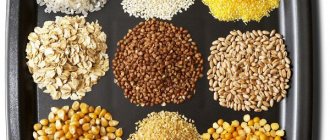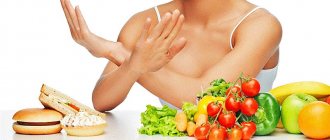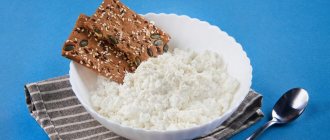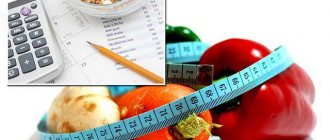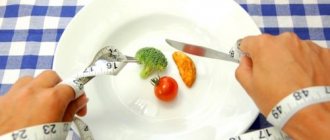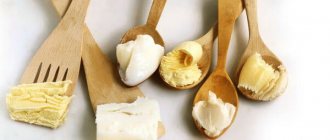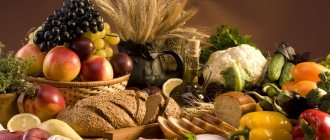Proteins are the “building blocks” of which our body is built.
There are two types of proteins: simple and complex. Simple proteins (proteins) are a chain of alpha amino acids.
Complex proteins (proteids) contain not only amino acids, but also a number of organic and inorganic substances - for example, metals.
Despite the primitiveness of some recipes, several hundred years ago food was healthy and natural. Previously, there were no recipes with mayonnaise, butter creams and other synthetic foods. People ate this hearty, healthy food on weekdays and holidays, and did well without the frills that we are so accustomed to today
However, all proteins are often called proteins—not only simple ones, but also complex ones. Sometimes the word “proteins” refers to sports nutrition mixtures whose main components are proteins. But such mixtures are far from being 100% protein - they also contain carbohydrates, fats, vitamins and microelements.
The body primarily obtains proteins from animal products: eggs, meat, poultry, seafood, fish and dairy products.
Chicken eggs are an easily accessible source of protein.
They are absorbed almost completely - 60-90%. Chicken egg protein is best absorbed - 98%.
Vegetable proteins, which are contained in legumes and cereals, are absorbed worse - by 20-40%
How does cooking method affect protein digestibility?
The digestibility of protein directly depends on the method of cooking:
- Thermal influence when preparing dishes - here it is important not to overdo it with temperature and time, since there may be practically no vitamins left in the food, but the food should still be healthy.
In such cases, for slow proteins, in particular cereals, pre-soaking in water is suitable; this will make the protective film of the grains more pliable and thereby reduce the thermal effect in order to preserve vitamins.
A double boiler can come to the rescue with this, as it provides a gentle cooking mode for food.
Cooking protein foods in a steamer helps preserve their usefulness
- Grinding will speed up the absorption of protein and its completeness; blenders and meat grinders will be useful in the kitchen; the less fibrous, the faster the body digests and breaks down protein foods.
TOP protein products for weight loss
- Chicken eggs
Athletes have long appreciated this product, which, let us remind you, is absorbed by 98%. And it’s not just the high content of beneficial amino acids. Affordable price also matters.
- Tuna
Fish with the highest protein content (24%). The body absorbs it by 95-98%.
- Cottage cheese
Milk protein is digested a little worse than meat and fish, but it contains the largest set of essential amino acids. It also helps stabilize cholesterol levels.
- Beef
Absorbed by 87-89%. Provides the body with essential amino acids, zinc, iron and a number of other important microelements.
- Greek yogurt
This savory dish never became popular with us, which is a pity. Greek yogurt not only replenishes protein, but also benefits digestion by keeping bifidobacteria at bay.
- Canned fish
Even after such treatment, the fish retains its life-giving protein. In addition, it is ready for use and is relatively inexpensive.
- Protein powder
An affordable and harmless to the body (in reasonable doses) source of protein, which is consumed not only by athletes, but also by ordinary people. For example, protein powder is sometimes prescribed to pregnant women.
- Chicken meat
Sports publications have long considered white chicken meat one of the best protein foods. Even if you don’t have time to cook dinner, you can always buy ready-made grilled chicken.
- Nuts
They contain plant protein, healthy fats and fiber. In addition, nuts are stored for a long time.
- Quinoa
An annual plant native to the Andes. Even the ancient Incas considered it incredibly useful and called it “golden grain.” The composition of amino acids in quinoa is similar to cow's milk. But this cereal contains not only protein - it contains vitamins, carbohydrates, phosphorus, calcium, iron and, of course, fiber.
Our environment influences the way we eat
Table of protein in foods
Every day an adult needs to eat up to 100 grams of protein (0.8-1.5 grams per kilogram of weight). Of these, 20% should come from plant foods, and 80% from animal products. But these figures only apply to people who do not have much physical activity in their lives. But for athletes, the norms are completely different: 200-300 grams of protein per day, and only half should come from food, and the athlete gets the other half from sports nutrition - special mixtures with a minimum content of carbohydrates and fats.
Table
Protein supplements for athletes are made primarily from whey and milk concentrates. Without any chemical treatment, they are filtered and dried. The most valuable quality of such a protein is its ease of use - it is a ready-made product that can be consumed anywhere and anytime.
Whey protein is taken after training as the body quickly absorbs it. Milk protein takes longer to digest, so this supplement is taken at night.
There is a special supplement for those who are forced to constantly monitor cholesterol levels or are trying to minimize the consumption of fats and carbohydrates. We are talking about whey protein that has undergone additional filtration. Fats and lactose (milk sugar) are almost completely removed from it.
This is interesting: Carbohydrates for Weight Loss: List of Fast and Slow Carbohydrates
Fast and slow proteins
Proteins are usually divided into fast and slow. This division is associated with different rates of their breakdown and absorption. Both types are equally important for the full functioning of the body.
Slow
From the name it is clear that the rate of absorption of these proteins is quite low. It takes about five to eight hours to completely process them. What are they needed for? They help the body cope with hunger for a long time, providing it with a large supply of energy. Slow-acting proteins are useful for those who want to lose weight.
These proteins work best if consumed in the evening. During a night's sleep, they are 100% completely processed. This approach will also help cope with the possible unbridled desire to eat something tasty and terribly high in calories.
Fast
Unlike slow proteins, fast proteins have an increased rate of digestion and absorption: only a few hours. Who needs them? Of course, athletes and people involved in hard physical work.
Nutritionists advise consuming them immediately before training and an hour after it.
How to combine them
The right combination of both types of proteins is necessary for good digestion. In this regard, the combined intake of egg whites and corn grits, beans, wheat flour and boiled potatoes works well. Dishes made from milk and rye, soy and millet are perfectly digestible. Slow and fast proteins are equally important for those who want to lose weight and those who want to gain weight. However, they will have a positive effect on people of both categories only if they comply with the daily norm, which we will talk about now.
Features of consuming protein products for weight loss
A significant number of modern women are concerned about becoming slim, and all sorts of fashionable diets allow them to lose extra pounds, thereby getting closer to the ideal and gaining the desired self-confidence.
Table of the ratio of proteins and other nutritional components in food
Protein diet: mechanisms of action
To fully experience the effectiveness of this type of diet, you must first understand the mechanism of its action on our body.
When consuming a significant amount of protein foods, our body does not receive the usual amount of vegetables and fruits, and with them complex carbohydrates, which serve as the initial fuel and source of energy. Proteins, becoming a source of energy, also stimulate the consumption of fat deposits, which leads to weight loss and weight loss.
Protein sources
The main rule when following this type of diet is the correct drinking regime: drinking about 2 liters of clean water of excellent quality will avoid the possible negative consequences of using a diet with a significant amount of protein consumed. With the help of water, normal intestinal motility is maintained, toxins are eliminated in a timely manner and preconditions for constipation are not created due to the lack of coarse fiber supplied with vegetables and fruits.
To understand the principle of nutrition during this period, you should consider a sample protein diet menu. It can last no more than 2 weeks, and it can be repeated 2 times a year.
10 Day Protein Diet Plan
So, the menu. You can make adjustments in it - for example, replace products with similar biological and nutritional value, depending on your own dietary preferences.
Hard cheeses made from skim milk - unique food products
Vegetable Protein Sources
As you can already understand, this is not all meat. Sources of plant proteins are:
- legumes;
- soy;
- pumpkin, flax, hemp seeds;
- nuts;
- green vegetables;
- seaweed and other seaweed;
- grain, bran, millet and rye (sprouts);
- flour and flour products.
First day
1First day
During the day, you can eat about 200 g of low-fat cottage cheese, 250 ml of kefir, boiled lean fish or lean meat, and quite a bit of fresh herbs - dill and parsley. If you feel very hungry, you can additionally eat 3 boiled eggs.
2Second day
Today you can add variety: instead of meat, use 350 g of boiled beans, again cottage cheese and kefir 200 g each, boiled shrimp and two soft-boiled eggs. Don't forget to drink water.
3Third day
Baked chicken breast or sea fish, two small cucumbers or tomatoes, baked beans, a cup of porcini mushrooms. You can drink green tea with lemon.
4Fourth day
You can pamper yourself a little: today the menu includes boiled broccoli with red fish, fried mushrooms, unlimited yogurt and one large apple. Chicken fillet should be baked with beans and seasoned with vegetable oil.
5Fifth day
For the whole day, you should divide 250 g of cottage cheese, a small portion of red cabbage salad with sunflower oil without salt, boiled turkey and low-fat kefir. We drink a lot of water.
6Sixth day
The sixth day is exactly the same as the first day.
7Seventh day
Today, a small indulgence is possible - a salad of your favorite vegetables with butter, fried beans and diet bread, unlimited unsweetened yogurt and boiled shrimp with eggs.
8Eighth day
The eighth day is similar to the second, do not forget to drink water.
9Ninth day
Boiled eggs (5 pcs. for the whole day), low-fat cottage cheese (300 g), a sprig of dill, stewed beans with chicken and mushrooms.
10Tenth day
Low-fat milk can be combined with bread, stew beans with any sea fish, 2 eggs and any amount of cottage cheese.
The diet is not considered difficult for those who prefer meat products. Vegetarians may be recommended a similar diet with soy products. After finishing the protein diet, you should gradually return to your usual diet, take vitamin complexes and nourish your body with minerals.
Menu for the week
A protein diet promotes rapid weight loss not only through the use of foods containing large quantities of protein, but also through a daily calorie deficit and a reduction in fast carbohydrates in the diet, therefore, when creating a menu for cutting, you should strictly adhere to the basic nutritional rules.
Monday
- Breakfast: two soft-boiled eggs, whole grain bread with avocado, coffee without sugar;
- Lunch: cheesecake with raspberries (using a sweetener);
- Lunch: baked turkey in sour cream, buckwheat, green vegetable salad with olive oil;
- Afternoon snack: Greek yogurt, 4 raw almonds;
- Dinner: boiled shrimp.
Tuesday
- Breakfast: ham, rice cake, tea;
- Lunch: 20 grams of nuts (almonds, hazelnuts and walnuts);
- Lunch: green vegetable salad, boiled chicken breast;
- Afternoon snack: 30 grams of cheese, coffee;
- Dinner: steamed fish, cucumbers.
Wednesday
- Breakfast: curd soufflé with currants;
- Lunch: 2 hard-boiled eggs, whole grain bread, lettuce;
- Lunch: buckwheat with turkey, Chinese cabbage and cucumber salad;
- Afternoon snack: yogurt, 10 grams of nuts;
- Dinner: fish and zucchini puree.
Thursday
- Breakfast: omelette with tomato, tea;
- Lunch: bean and ham salad;
- Lunch: boiled turkey, green peas and carrots;
- Afternoon snack: a glass of milk;
- Dinner: seafood.
Friday
- Breakfast: hard cheese, avocado, coffee;
- Lunch: salad of hard-boiled eggs, cabbage and bell pepper;
- Lunch: baked rabbit, vegetable stew with brown rice;
- Afternoon snack: steamed herring, cucumber;
- Dinner: Greek yogurt.
Saturday
- Breakfast: stewed asparagus, cheese, tea;
- Lunch: cold cuts, celery juice;
- Lunch: meat with rice noodles, salad;
- Afternoon snack: cheesecakes with sweetener in the oven;
- Dinner: fermented baked milk without additives.
Sunday
- Breakfast: vinaigrette of vegetables and boiled meat, coffee;
- Lunch: fresh cabbage salad, nuts;
- Lunch: soup with vegetables and turkey, buckwheat bread;
- Afternoon snack: green peas with cheese;
- Dinner: cottage cheese with raspberries.
High Protein Foods
It is known that a diet based on protein foods is very effective and easily tolerated, since protein foods perfectly dull the feeling of hunger.
It is very important during this period to give up sugar and all products containing it. They say that on a protein diet a person can lose up to 8 kg per week, but a protein diet can only be followed for a few weeks and then take a break.
Nuts are rich in plant protein
First of all – health
Before you go on this diet, you must make sure that giving up fats and carbohydrates in favor of proteins will not cause harm to the body. The fact is that an excess of protein foods overloads the kidneys, and the body begins to feel a lack of calcium and microelements. As for people who have an ardent love for sweets, they will feel dizzy until their body adapts to the new diet.
A protein diet is suitable for people who lead an active lifestyle, play sports, and monitor their condition.
For ladies of Balzac's age and those who are obese, even if they have not yet left puberty, a protein diet is not suitable - the load may be unbearable.
Reasonable menu
Nutritionists advise that when following a protein diet, do not give up carbohydrates completely, but add complex carbohydrates to protein foods: buckwheat, oatmeal and brown rice. It will be completely harmless to consume 100 grams of rye bread and 50 grams of dried fruits per day.
The main products of the protein diet are:
- eggs;
- lean meat - chicken breasts, rabbit, veal;
- seafood, low-fat fish;
- dairy products of limited fat content - cottage cheese, fermented milk drinks, white cheeses such as feta cheese;
- nuts;
- mushrooms;
- legumes
You definitely need to eat as many vegetables and fruits as possible, with fruits in the first half of the day and vegetables in the second. You need to eat little by little, but up to 6 times a day, and there is no need to give up microdinners. The best dinner in the world is a vegetable salad with olive oil and a piece of dark bread.
Seasonings should be limited to lemon juice, spices, garlic, onions, soy sauce, balsamic vinegar and various types of vegetable oils.
Additional recommendations:
- Be sure to drink a lot of water - up to 1.5 liters per day, but not during meals, but between meals.
- Be sure to monitor your well-being.
- Be sure not to drink alcohol.
- Be sure not to fry, do not add butter to dishes, do not use mayonnaise and other fatty sauces.
Protein products
What are the benefits of protein?
In the scientific community, high-molecular organic compounds, which we simply call proteins, bear the proud title of guardians and organizers of life. And this is not without reason. Once in the stomach with food, they are broken down into amino acids, which immediately begin to take an active part in the physiological processes of the body:
- participate in the production of hormones;
- ensure blood clotting;
- regulate the functioning of the nervous system (lack of protein affects coordination);
- affect the activity of the kidneys and liver;
- the delivery of nutrients to cells is also controlled by protein;
- without it, neither the restoration of old tissues nor the growth and construction of new ones is possible - including muscles;
- it provides the body with energy;
- Some proteins act as antibodies, resisting various diseases and strengthening the immune system.
Don’t think that proteins are exclusively meat and cottage cheese!
The body is able to synthesize some amino acids itself. But this part is small, so our body cannot do without regular replenishment of its reserves from the outside. And you can’t do without a list of high-protein foods, which you should print out and hang on the refrigerator, or better yet, memorize it - you’ll have to refer to it often.
Egg diet
There are different opinions regarding eggs and blood cholesterol. Some claim that eggs increase cholesterol, while others deny it.
An egg has two components - white and yolk. The protein component of an egg is only ten percent protein itself, and the rest is water. The yolk contains a large percentage of cholesterol, and this is what raises serious doubts about the usefulness of this product. Many nutritionists are inclined to believe that eating eggs reduces the percentage of good cholesterol in the blood and increases the percentage of bad cholesterol, which may not have the best effect on the functioning of the cardiovascular system. But there is an “antidote”: eating eggs together with antioxidants stops the process of increasing bad cholesterol.
Eggs are used as the basis for this diet because they have low calorie content (70 kcal) and are easily absorbed by the body.
Here are the different types of egg diets depending on the duration.
Diet for a week. This diet is the simplest. During the diet, you need to eat only certain foods: eggs, meat, fish, cottage cheese, vegetable salads, fruits. It is recommended to drink water and herbal tea, as well as low-fat kefir and juices. Black tea, coffee, fats, baked goods and sweets should be excluded from the diet.
From the recommended products you can create a fairly varied menu. This is the advantage of this diet
The diet is designed for a month. This diet gives noticeable results. In some cases, it was possible to lose up to 25 kilograms. The main condition of this diet is the consumption of large amounts of clean water. Vegetables consumed during this diet must be boiled in their own juice, without water. It is allowed to add salt and spices to them. Any oils and fats are strictly prohibited on such a diet. If the diet has been broken, then you need to start all over again.
Types of protein
The downside is that it is prohibited for those who suffer from allergic reactions to eggs. During pregnancy and breastfeeding, this diet is also contraindicated. In general, before starting this diet, you need to get medical advice, since the egg diet is not suitable for those who suffer from chronic diseases of the kidneys, blood vessels and heart. Caution should be exercised by people suffering from cholelithiasis, as the yolk increases the secretion of bile, which can lead to an attack.
In the twenty-first century, the culinary industry has reached its apogee
Fruits and vegetables
In this group, banana can easily be called the cheapest source of protein. However, it contains a lot of sugar, so you shouldn’t get carried away with the fruit. You should take a closer look at green fruits. For example, avocado. It makes amazing sandwiches, and one fruit with this consumption will last for a long time. It is recommended to take a closer look at cucumbers, zucchini and zucchini, Brussels sprouts and cauliflower, and asparagus. Figs in any form and even potatoes contain a lot of protein. Only it needs to be baked so that the protein received by the body is better absorbed.
Ducan's diet
The most popular protein diet is the Dukan diet. It was developed on the basis of eating foods with a high protein content and the maximum exclusion of carbohydrates in any form from the diet.
Pierre Dukan took 40 long years to formulate general principles of diet. The impetus for the creation of this nutritional system was a case from the medical practice of a young doctor, nutritionist Dukan. An obese patient approached him with a desire to undergo treatment, but with the only condition - meat must be present in the diet. To the patient’s surprise, this was a success – after five sessions, the weight decreased by several kilograms.
Long-term observations of nutrition, quantity and quality of food consumed resulted in 4 stages of weight loss:
Attack stage This stage is aimed at active weight loss by limiting the menu to protein foods only. The attack lasts at least 2 days, maximum 7 days, depending on the amount of extra pounds. The average weight loss during the attack period is up to 4 kilograms. In addition to a protein diet consisting of 72 permitted foods, you need to take 1.5 tablespoons of oat bran daily and set aside 20 minutes for physical activity.
Stage of achieving the correct weight The timing of the stage depends on how many unnecessary kilograms need to be destroyed. Based on the methodology, one week is given for one kilogram of excess weight. The menu becomes even more diverse, since 28 types of vegetables will be added to the proteins. Vegetables can be consumed in any quantity, the mass of bran is increased to 2 tablespoons, and physical activity is increased to 30 minutes.
Stage of consolidation of the achieved result There is no weight loss at this stage; bread, cheese, foods containing starch, and fruits are added to the menu. The time for physical exercise is reduced to 25 minutes, the daily intake of bran is 2.5 tablespoons. The duration of the consolidation stage is 10 days for each kilogram lost.
Stabilization stage The main requirements of the stage are 20 minutes of activity and 3 tablespoons of bran every day. Proper nutrition - at the request of the patient. Every week, a day is strictly observed on which only proteins are eaten. The stabilization stage lasts for the rest of your life after achieving normal weight.
What is the secret to losing weight according to Dukan? After all, the diet at the stage of achieving the correct weight includes 100 products in the list! Everything is very simple, the diet is based on the biochemical reactions of the body. To digest protein, the body needs to spend much more energy than fat or carbohydrates. The necessary energy is drawn from fat reserves without harming muscle mass. Another big advantage of a protein diet is that the feeling of fullness with protein foods appears much faster and lasts longer than when eating carbohydrates.
During the passage of all stages of the diet, a person develops special eating habits.
Refusal of pure sugar, fats and other foods that do not fall under the “Dukan list” for a long time will help to avoid nutritional breakdowns, and regular intake of oat bran helps to improve the functioning of the gastrointestinal tract.
To digest protein, the body needs to spend much more energy than fats or carbohydrates - this is the main secret of the Dukan diet
Ducan's diet
How to eat right?
Health is the state of the body. Often speaking about health, we forget the very meaning of this concept. When we say “I want to be healthy,” none of us think about how it really is? How can we be healthy the right way? After all, there are many options and a large selection of healthy food, water, recreation, etc., but it is different for everyone.
Each person has his own capabilities, abilities, needs, and it’s not to say that this or that lifestyle will suit everyone and everything; to put it simply, a healthy lifestyle is not a panacea! Let's try to figure out what a healthy lifestyle is?
A healthy lifestyle is a structural phenomenon that consists of a large number of components. To achieve the desired result, you need to follow the following rules:
- From childhood, our parents teach and teach us the basics of health and a healthy lifestyle;
- bad and negative habits - you need to give them up. They entail enormous damage not only to health, but also to a person’s appearance, behavior and attitude towards life;
- be able to form a healthy nutritional culture, which involves eating healthy food in moderation;
- be sure to lead an active lifestyle that will correspond to the condition of the body;
- carry out physical activity that will be age appropriate;
- know and observe the rules of hygiene, personal and, of course, public.
The concept of healthy lifestyle can have quite diverse definitions. There are certain aspects that help more accurately formulate the concept of a healthy lifestyle:
- The spiritual aspect is the ability to set guidelines in life, pursue them and strive for them.
- The intellectual aspect makes it possible to search for the necessary information and use it correctly.
- The emotional aspect allows you to more clearly control your emotions and respond adequately to problems.
- The physical aspect helps maintain good health and strengthen the body's defense mechanisms.
Every person strives for self-improvement. There are a large number of recommendations, following which you can achieve a certain level of health.
healthy lifestyle
Basic recommendations
- When you wake up in the morning, don’t forget to wake up your body and do exercises;
- Plan your meals correctly so that you eat as many healthy substances as possible. In winter and spring, when the body especially needs vitamins, add vegetables and fruits to your diet;
- To the best of your body's ability, try to harden yourself. Start your morning by washing your face with cool water, gradually moving on to wiping. This will protect you from illness and colds, and will also strengthen the nervous system;
- Be sure to eat meat and fish - these foods are high in protein. It is the protein that is responsible for the formation of the immune system;
- avoid and protect yourself from negativity and stress;
- give up bad habits, they destroy the immune system;
- sleep at least 7-8 hours a day;
- Do not forget about personal hygiene, wash your hands always when you come from outside and before eating.
Everything written in this article is taken from personal experience and daily activities.
Daily protein intake
Each person needs an individual amount of protein daily. It depends on gender, weight and other factors. It is important not to overdo it and not eat only protein-rich foods. In any case, nutrition should be balanced and rational. Eating too much protein will not lead to increased muscle growth, although some people believe it will. Even 300 grams of pure protein per day will not cause the body to produce muscle tissue faster than possible.
Research says that for athletes and people who are trying to gain weight, the protein norm is equal to 1.5-2.5 g per 1 kg of weight. That is, with a weight of 70 kg, a man needs about 200 g of protein, a woman with a weight of 60 kg needs 165 g per 1 kg of weight. For weight maintenance or weight loss, this value is reduced by 10% or 20% respectively. But do not forget that this is purely individual, and you should rely on your feelings, observing changes in your figure and well-being. It is impossible to understand from the first day whether the diet has been chosen correctly; at least a month must pass, after which you can adjust your diet.
Protein-carbohydrate diet
A beautiful appearance, a good, toned figure and excellent health are the key to success for any woman. However, choosing the right type of nutrition is not so simple. One of the most popular diets in the 21st century is the protein-carbohydrate diet.
How does this diet affect the human body?
The essence of the diet is alternating carbohydrate, protein and mixed days. The main advantage is that you can eat a large variety of foods while losing extra pounds. In order to start implementing the diet, it is advisable to undergo a little training so that the body can more easily adapt to the new diet.
In order not to waste time on the question “what to cook today?”, it is better to think through the diet menu in advance and gradually begin to switch to it. Just a few days after changing your diet, you can notice that the body begins to feel better, the hair looks healthier, the nervous system becomes stronger, and lethargy, insomnia and apathy go away. It is important to understand that the extra pounds will not go away quickly, since the diet is designed for a long period of time. Thanks to it, it is not water or muscle mass that is removed from the body, but the fat itself. In a week, a person can lose from 2 to 4 kilograms. However, it is worth remembering that this diet also has contraindications. A protein-carbohydrate diet is not suitable for people with grade 2 and 3 obesity. The bottom line is that excess weight will quickly cease to be removed, as low physical activity is involved. This diet is also not recommended for people leading a sedentary lifestyle.
A protein-carbohydrate diet is not suitable for people with grade 2 and 3 obesity. The bottom line is that excess weight will quickly cease to be removed, as low physical activity is involved
The main meaning of the program
The first two days should start with eating protein foods, and the third day with carbohydrate foods. It is worth noting that the so-called mixed day plays an important role. It includes foods from protein and carbohydrate days.
The diet of this diet is quite wide. You can eat eggs, meat products, cottage cheese, non-starch vegetables, and seafood on protein days, as well as peas, beans, fruits, boiled chicken and oatmeal on carbohydrate days. Such a varied diet gives the body few calories and at the same time saturates it with all the beneficial vitamins.
Amount of protein in various foods (per 100 g)
Pros and cons of a protein-carbohydrate diet
1Pros
- High efficiency. This diet can be followed for about a month without causing damage to your body.
- Simple and varied food menu.
- The results exceed all expectations and last a long time.
- You will not feel hungry, since all the products are very satisfying and nutritious.
2Cons
- Eating large amounts of foods that contain protein, which can cause nausea.
- Daily mandatory physical activity. Thanks to them, proteins are absorbed.
- It is necessary to give up many familiar foods, such as potatoes, flour products, overly sweet fruits, fast food and alcoholic drinks.
A protein-carbohydrate diet has more positive factors than negative ones. That's why it is one of the most famous diets in the world.
Meat and fish products
Among the cheap protein options, lard and cracklings should be noted first. These products are very inexpensive, but contain a large amount of protein. Like chicken, which is much cheaper compared to other types of meat. By the way, to save even more, it is recommended to buy a whole carcass rather than individual parts. Chicken is the most powerful source of protein.
Rabbit meat contains a lot of protein, but such meat is not a budget option. You can focus on by-products, since they are noticeably cheaper. Even chicken and pork liver can provide the body with most of the daily protein requirement.
As for fish, of all the representatives of this family, flounder, catfish, saury and cod deserve special attention. They are relatively inexpensive, but a 100 g serving will provide the body with almost half of the daily protein requirement. Tuna is more expensive, but it is better because it is rich not only in protein, but also in healthy fats. By the way, fish by-products, like meat by-products, also contain a lot of protein. Herring, pollock, mackerel, hake, sardine and saury are suitable for nutrition in order to replenish the protein content in the body.

